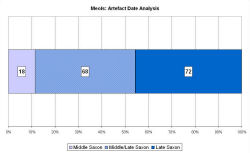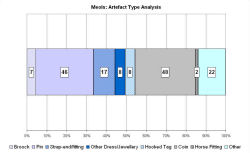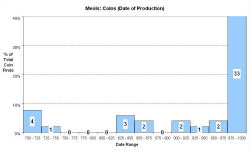Fingerprint charts for i) artefact date analysis, ii) artefact type analysis, iii) artefact metal analysis and iv) coins – date of production




References: Bu'lock 1960; Griffiths et al. 2008
Archives:
http://ads.ahds.ac.uk/catalogue/search/fr.cfm?rcn=NMR_NATINV-66298
Meols is situated on the northern coast of the Wirral peninsula. The place name derives from Melr, meaning 'sand-hills' or 'sand-dunes'. It refers to the historic townships of Little and Great Meols, representing the coastal hinterland of the north-western Wirral shore. This has suffered significant coastal erosion for the last 200 years and substantial numbers of artefacts, ranging in date from the Mesolithic to the post-medieval period, have been found across a distance of 8km. The VASLE dataset was kindly supplied by David Griffiths, based on the Meols report, now published as Griffiths et al. (2008).
Early medieval material is restricted to a short stretch of coast, west of an area that produced Roman finds. Over 100 artefacts have been recorded, including post-Roman objects of the 6th to 8th centuries, as well as Late Saxon and Anglo-Scandinavian material. The coins include primary and secondary sceattas, Hiberno-Norse coins, and Anglo-Saxon silver pennies of the 10th and 11th centuries. There are also penannular brooches, mounts, disc-headed and ringed pins, strap-ends, hooked tags, stirrup mounts, and iron knives and spurs.
Griffiths et al. (2008) see the 6th-century finds within the context of a post-Roman ecclesiastical presence in western Britain, and a possible beach or coastal market. The 7th to 9th century objects indicate a comparatively low level of activity in the Middle Saxon period, although the two 8th-century sceattas represent the north-western extremity of coin circulation in England at this time. The material is reminiscent of finds from 'productive sites' and may indicate informal rural market activity. From the 9th century the finds indicate an upsurge in external contacts. The occurrence of stycas reflects the westwards expansion of the Kingdom of Northumbria. The material also includes a significant number of Viking-period objects, including Hiberno-Norse forms such as the ringed pins, as well as objects such as hooked tags, dress pins and strap-ends familiar from Anglo-Saxon sites. The Meols assemblage is therefore a curious hybrid of Viking and Anglo-Saxon elements. A Scandinavian-style bird-shaped attachment from a balance hints at market activity and there is no doubt about the presence of Viking traders in the 10th century. However, there are no coins from Meols dating from the heyday of Chester minting between AD 915-50, and Griffiths (2008, 406) has suggested that 'Meols's fortunes stand in curious juxtaposition to Chester's'. Given the official control and taxation of trade through Chester, it may be that Meols operated as a haven for Scandinavian traders looking for a less-regulated trading environment away from the attention of the king's reeves.
Fingerprint charts for i) artefact date analysis, ii) artefact type analysis, iii) artefact metal analysis and iv) coins – date of production




© Internet Archaeology/Author(s)
URL: http://intarch.ac.uk/journal/issue25/2/4.4.35.html
Last updated: Tues Apr 21 2009